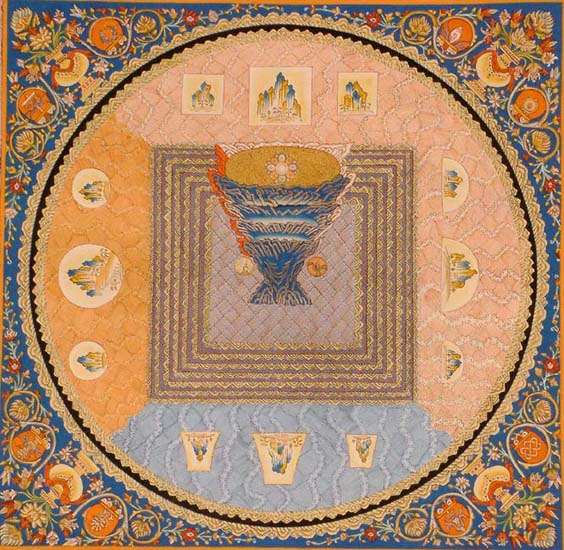Sumeru - A Question of Size
According to Vasubandhu's Abhidharmakośabhāsyam, Sumeru is 80,000 yojanas tall. The exact measure of the yojana is uncertain, but some accounts put it at about 24,000 feet, or approximately 4 1/2 miles. It also descends beneath the surface of the surrounding waters to a depth of 80,000 yojanas, being founded upon the basal layer of Earth. Sumeru is often used as a simile for both size and stability in Buddhist texts. Sumeru is said to be shaped like an hourglass, with a top and base of 80,000 yojanas square, but narrowing in the middle (i.e., at a height of 40,000 yojanas) to 20,000 yojanas square. Sumeru is the polar center of a mandala-like complex of seas and mountains. The square base of Sumeru is surrounded by a square moat-like ocean, which is in turn surrounded by a ring (or rather square) wall of mountains, which is in turn surrounded by a sea, each diminishing in width and height from the one closer to Sumeru. There are seven seas and seven surrounding mountain-walls, until one comes to the vast outer sea which forms most of the surface of the world, in which the known continents are merely small islands. The known world, which is located on the continent of Jambudvīpa, is directly south of Sumeru. The dimensions stated in the Abhidharmakośabhāsyam are shown in
the table below:
The 80,000 yojana square top of Sumeru constitutes the "heaven" (devaloka) of the Thirty-three gods, which is the highest plane in direct physical contact with the earth. The next 40,000 yojanas below this heaven consist of sheer precipice, narrowing in like an inverted mountain until it is 20,000 yojanas square at a heigh of 40,000 yojanas above the sea. From this point Sumeru expands again, going down in four terraced ledges, each broader than the one above. The first terrace constitutes the "heaven" of the Four Great Kings, and is divided into four parts, facing north, south, east and west. Each section is governed by one of the Four Great Kings, who faces outward toward the quarter of the world that he supervises. 40,000 yojanas is also the height at which the Sun and Moon circle Sumeru in a clockwise direction. This rotation explains the alteration of day and night; when the Sun is north of Sumeru, the shadow of the mountain is cast over the continent of Jambudvīpa, and it is night there; at the same time it is noon in the opposing northern continent of Uttarakuru, dawn in the eastern continent of Pūrvavideha, and dusk in the western continent of Aparagodānīya. Half a day later, when the Sun has moved to the south, it is noon in Jambudvīpa, dusk in Pūrvavideha, dawn in Aparagodānīya, and midnight in Uttarakuru. The next three terraces down the slopes of Sumeru are each longer and broader by a factor of two. They contain the followers of the Four Great Kings, namely nāgas, yaksas, gandharvas, and kumbhāndas. The names and dimensions of the terraces on the lower slopes of Sumeru
are given below:
Below Sumeru, in the seas around it, is the abode of the Asuras who are at war with the Thirty-three gods.
Painting of Sumeru found in Buddhist cave sanctuary in Chinese Turkestan |
|||||||||||||||||||||||||||||||||||||||||||||||||||||||||||||||||||||||||||
| Copyright Notice
All pictures and
photos on this page, unless otherwise notated, have been gathered from
pubic domain sources or are available under
Article Qoutes all
have links to their appropriate source and are noted. All other text not
so noted is available under the terms of the
All information
on this page is used only for non profit educational purposes. All reasonable
attempts have been made that no credits
|
